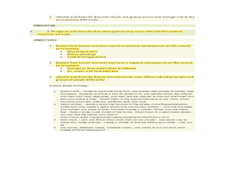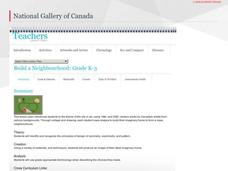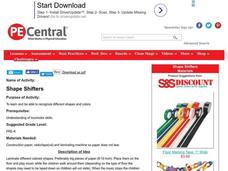Curated OER
African Ecology and Art
Explore Samburu culture as students examine art work by many artists and compare and contrast their styles. They view Kenyan images and find Kenya on the map. Students identify conflict in the animal world and draw animals and record in...
Hawaiʻi State Department of Education
Illustrating Text
Ideas like this are highly effective for helping build better reading comprehension. The class listens to an excerpt from a grade-appropriate text, and they discuss what clues or words helped them visualize the scene. They then read a...
National Gallery of Canada
Transformation
Create colorful cool or warm butterflies with simple materials. Class members draw their designs, spray the marker to diffuse the colors, and attach pipe cleaners to form the shape of a butterfly with antennae. Individuals must be able...
Center for Learning in Action
Density
Explore the concept of density within states of matter—gases, liquids, and solids—through a group experiment in which young scientists test objects' texture, color, weight, size, and ability to sink or float.
Curated OER
Marvellous Mosaics
Introduce your class to the beauty found in Muslim mosques by engaging them in a culturally inspired mosaic art project. They view and discuss the nature of the mosaics found in mosques and then they use scraps of colored paper and black...
Metropolitan Museum of Art
Islamic Art and Geometric Design
After an overview of Islamic traditions and art, young artists create their own geometric shapes and patterns using only a straightedge and a compass.
Curated OER
How to Tame a Field Trip to the Zoo
Keep your pupils focused on field trip learning objectives with before, during, and after activities.
Curriculum Corner
Coniferous and Deciduous Trees
What are the differences between coniferous and deciduous trees? Supplement your tree lessons with a set of activities that has learners describing, naming, comparing, and reading about deciduous and coniferous trees. The activities are...
Curated OER
Ancient Egypt
Pupils complete a series of activities to discover life in ancient Egypt. They create want ads for pyramid workers, design vocabulary flash cards and dictionaries, and research famous Egyptians. They also research the "Curse of the...
Space Race
Sensory Detectives
Test your learners' sensory awareness with three hands-on activities that ask pupils to use their other senses to identify and describe everyday objects hidden from sight.
Illinois Mathematics and Science Academy
A Search for Symbolism in The Great Gatsby
After reading The Great Gatsby, groups return to the text and note passages where Fitzgerald uses symbols and color imagery in his narrative. They then develop a presentation that explains the context, the implications, and possible...
Curated OER
Sediment Sleuths
Are you looking for a good, solid lesson on sedimentary rocks? This one, produced by the Illinois State Museum, is just such a lesson. Middle schoolers identify common rocks and minerals by analyzing sediments from local water sources....
Alabama Learning Exchange
Yummy Apples!
Young learners listen to a read aloud of Gail Gibbons book, Apples and the story A Red House With No Windows and No Doors. They compare characteristics of a number of kinds of apples, graph them and create a apple print picture. Learners...
Curated OER
Food
This activity is sure to interest all learners! To learn new food vocabulary, the teacher does an initial read of Sip, Slurp, Soup, Caldo, Caldo, Caldo. After the first read, each learner gets a series of plastic...
Curated OER
"Circles of Strength: What Do You Stand For?" ~ A Reflection of Us~
Middle schoolers determine how they are included in "Circles of Strength." For this character activity, students reflect on how they are part of "Circles of Strength" in the "Circle of Life." They make an individual circle that includes...
Curated OER
Introduce Vocabulary: I Am Planet Earth (Marzollo)
Explore the world's beauty with Jean Marzollo's colorful book I Am Planet Earth, the context of a vocabulary study focused on the following in-text words: globe, jungle, paddy, planet, and valley. Discuss the...
National Gallery of Canada
Build a Neighbourhood
What's special about your neighborhood? Build one with your class to find out. Individuals create their dream homes that, when completed, will be placed together around a green space in order to create a neighborhood. Learners also...
Learning Games Lab
Scientific Graph Reading
Interpreting graphs is an essential skill for young scientists. An interactive online lesson gives individuals an opportunity to review the components of a graph and learn to read and interpret the shape of a graph. The lesson includes...
American Museum of Natural History
Atomic Mobile
Structure an activity around atoms. Learners use their knowledge of the parts of atoms—the protons, neutrons, and electrons—to build a model of a carbon atom. Scholars create a nucleus by using clay balls to represent the protons and...
Mathematics Vision Project
Module 6: Congruence, Construction, and Proof
Trace the links between a variety of math concepts in this far-reaching unit. Ideas that seem very different on the outset (like the distance formula and rigid transformations) come together in very natural and logical ways. This...
Education Development Center
Language of Algebra
Don't rush into algebra, let learners visualize, guess, and predict their way to a successful math career. The introductory unit incorporates beginner algebraic concepts with shapes instead of variables. Young mathematicians use a...
Curated OER
Shape Shifters
Students recognize different shapes and colors. When the music stops students should move to and stand on a shape. Ask students "who is standing by a square, circle," etc., and ask what color they are standing on.
Curated OER
Imagination Travel
Students watch video segments on shapes and patterns. They create their own pattern within shapes.
Curated OER
Hands and Feet of Many Colors
Students perform activities that involve color and shape discrimination. They play games to practice memory skills. Students recognize body parts to participate in activities.























